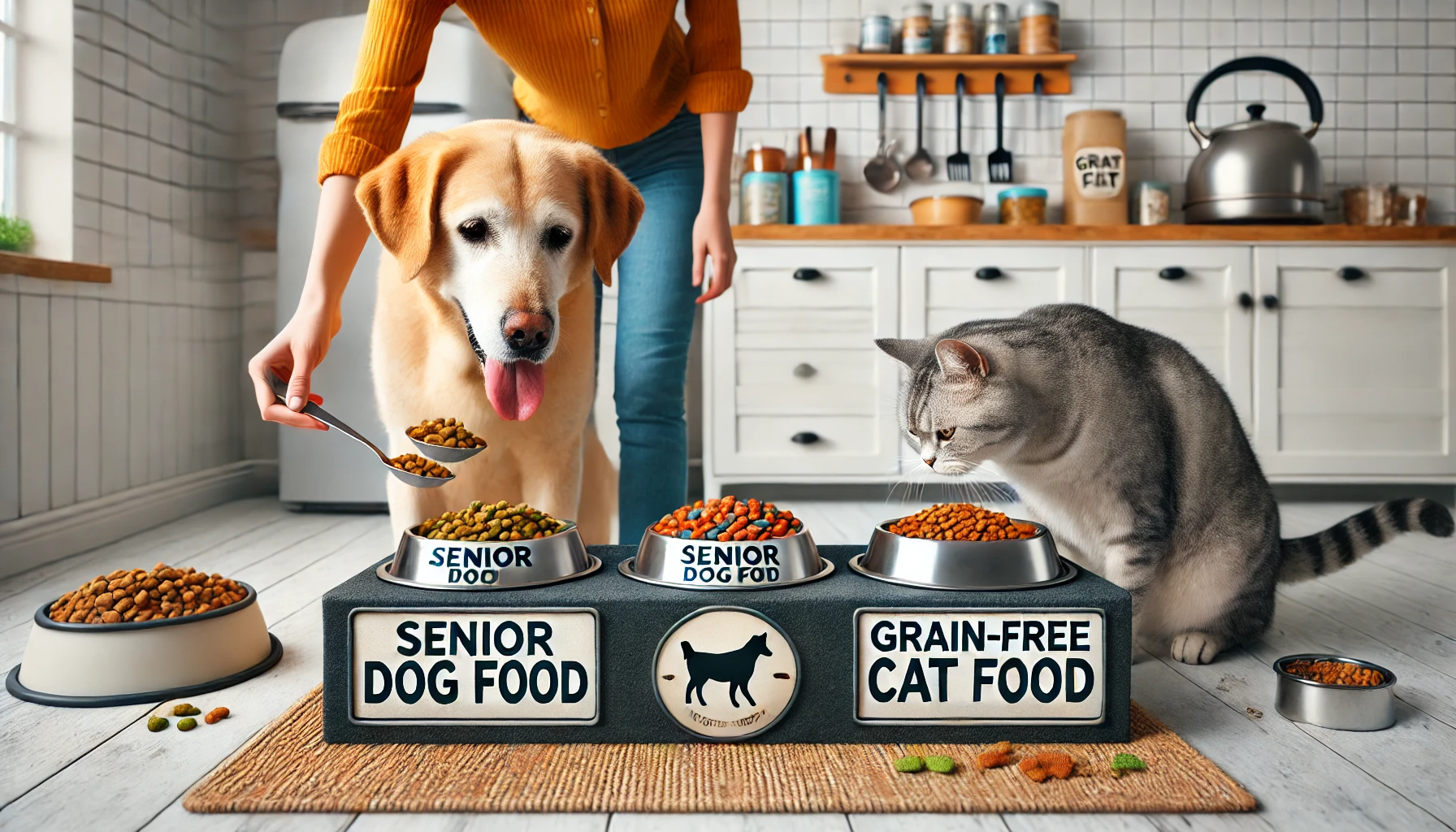Managing pets with varying dietary needs in a single household can be challenging but is entirely achievable with a structured approach. Whether you have a senior dog requiring a low-calorie diet or a cat with a grain-free preference, balancing their nutritional needs ensures everyone stays healthy and happy. Here’s a comprehensive guide to managing different dietary requirements for your furry family members.
Understanding Why Pets Have Different Dietary Needs
Pets may require unique diets due to age, breed, size, or medical conditions.
Common Factors Influencing Dietary Needs
- Age:
- Puppies and kittens need high-calorie, nutrient-dense diets for growth.
- Adult pets require maintenance diets to sustain energy levels.
- Senior pets benefit from foods that support joint health and lower calorie intake.
- Breed and Size:
- Large dog breeds may need diets with glucosamine for joint support.
- Small breeds often prefer smaller kibble sizes with higher calorie density.
- Medical Conditions:
- Pets with allergies may require limited-ingredient or grain-free diets.
- Diabetic pets need controlled carbohydrate levels.
- Pets prone to obesity benefit from low-calorie, high-fiber foods.
- Activity Levels:
- Active dogs or working breeds often require higher protein and fat.
- Sedentary pets benefit from calorie-controlled diets to prevent weight gain.
Creating a Feeding Routine
A well-structured feeding routine is crucial for managing multiple diets in one household.
Designate Separate Feeding Areas
- Individual Feeding Stations: Assign each pet their own space for meals to prevent food theft or competition.
- Barriers and Gates: Use baby gates or close doors to separate pets during feeding time.
- Elevated Spaces: Place cat food on countertops or shelves to keep it out of reach of dogs.
Feed Pets on a Schedule
- Consistent Meal Times: Feed pets at the same time each day to establish a predictable routine.
- Remove Uneaten Food: Take away bowls after a set period to prevent one pet from eating another’s food.
Choosing the Right Food for Each Pet
Selecting appropriate diets for your pets ensures their individual needs are met.
Consult a Veterinarian
- Work with your vet to determine the best food for each pet’s specific needs.
- Discuss portion sizes and feeding frequencies based on their age, size, and health conditions.
Label Food Containers
- Use labeled, airtight containers to store each pet’s food.
- Clearly mark the containers with names or feeding instructions to avoid mix-ups.
Preventing Food Theft
Pets may be tempted to eat food that’s not meant for them, especially if it smells appealing.
Supervise Feeding Times
- Stay nearby during meals to ensure pets stick to their designated bowls.
- Redirect any pet attempting to eat another’s food.
Use Feeding Tools
- Automatic Feeders: Dispense food for specific pets at set times, helping control portions.
- Microchip Feeders: Open only for the designated pet, ensuring others can’t access the food.
Managing Treats
Treats are an essential part of training and bonding but should be managed carefully in multi-pet households.
Offer Treats Specific to Dietary Needs
- Choose treats formulated for each pet’s requirements, such as low-calorie options for overweight pets or grain-free treats for those with allergies.
Avoid Sharing Treats
- Give treats individually to prevent pets from eating something unsuitable.
- Use treats as an opportunity to reinforce positive behaviors, like staying at their feeding station.
Addressing Challenges
Picky Eaters
- Offer a variety of flavors and textures to determine their preferences.
- Warm wet food slightly to enhance its aroma and make it more appealing.
Overeaters
- Use slow-feeder bowls to prevent gulping and reduce the risk of overeating.
- Measure portions precisely using a food scale or measuring cup.
Pets with Medical Conditions
- Work closely with your veterinarian to adjust diets as needed.
- Monitor your pet’s health regularly to ensure the diet is effective.
Monitoring Each Pet’s Health
Regular health monitoring ensures that your pets’ diets are meeting their needs.
Track Weight and Body Condition
- Weigh your pets monthly to detect any weight gain or loss.
- Use a body condition score chart to assess if they’re underweight, ideal, or overweight.
Observe Energy Levels
- Ensure your pets maintain healthy energy levels that match their activity requirements.
Monitor Digestive Health
- Look for changes in stool consistency, frequency, or color, which can indicate dietary issues.
- Consult your vet if you notice persistent vomiting, diarrhea, or loss of appetite.
Encouraging Harmony During Mealtime
Mealtime can be stressful if pets compete for food or resources. Creating a calm environment encourages harmony.
Establish Rules and Boundaries
- Train pets to wait for their turn to eat, using commands like “stay” or “wait.”
- Reward good behavior during feeding time to reinforce positive habits.
Reduce Anxiety
- For anxious eaters, feed them in a quiet, secluded space where they feel secure.
- Use calming aids like pheromone diffusers if mealtime stress persists.
Tips for Long-Term Success
Regularly Reevaluate Diets
- As pets age or their health changes, their dietary needs may evolve. Schedule periodic vet visits to reassess their diets.
Keep Open Communication with Your Vet
- Discuss any concerns or challenges, such as weight fluctuations or food preferences, to adjust feeding plans as needed.
Educate Family Members
- Ensure everyone in the household understands each pet’s dietary needs and feeding routine.
Conclusion
Managing pets with different dietary needs requires organization, patience, and attention to detail. By establishing separate feeding areas, using the right tools, and monitoring their health, you can ensure all your pets thrive. A well-thought-out feeding routine not only meets their nutritional needs but also fosters a harmonious environment in your multi-pet household.

